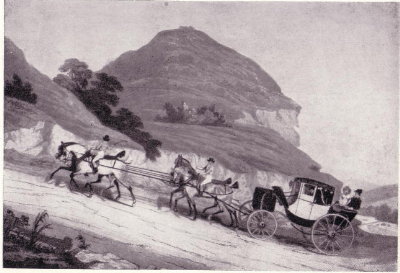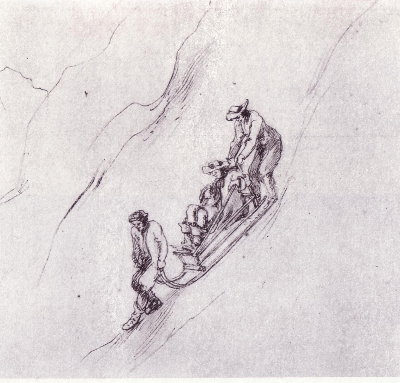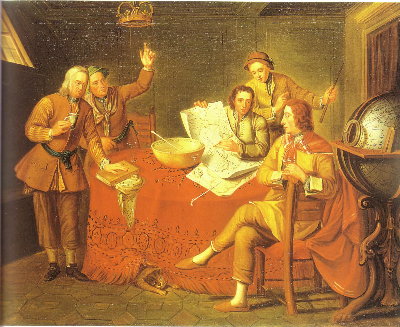Taking a Carriage on the Grand Tour
by
Sharon
Wagoner
yardoftin@georgianindex.net

Postchaise by James Pollard
The round of visits to cities in France and Italy with the possible
addition of visits to Austria, Germany, and the Netherlands which made up the
itinerary of the Grand Tour served as a hands-on education for young noblemen in
the eighteenth century. These travelers were the first tourists; in fact the
term tourist is derived from the Grand Tour. Some of these travelers chose to
take their own coach with them. We today might like to take our own car when
possible because it is more familiar to us, but in those pre-insecticide days
there was always a risk of renting a carriage which was infested with fleas or
simply in poor repair. What was it like to take your coach with you on the
eighteenth century Grand Tour?
The carriage itself was generally pulled by a team of two to four horses
and might be a chaise guided by a postillion riding one of the lead horses or a
coach controlled by a coachman who sat on the box at the front of the carriage
and drove the team with reins. Carriages often had a roof of leather over a
metal frame which could be let down like a convertible roof in good weather.
They were high slung so as to pass over rough roads more easily. A carriage was
entered by a side door with steps that folded onto the coach floor. The interior
was richly upholstered with fabric and seats padded with horsehair with an
overlay of goose down filled squabs. The interior might include seats that
folded down into a travel bed and compartments for guns, liquor, a telescope,
and maps.
A complement of servants for a nobleman who intended to spend one to
four years traveling Europe on the Grand Tour would include two coachmen for
each carriage, a pair of grooms for each carriage, armed outriders, and a
tutor/guide at the least. Other possible servants might include a valet and a
secretary.
If the tourist started from London it was a day long drive to Dover with
stops every 8 to 10 miles to exchange the four horse team for fresh horses. The
coach traveled at a speed of about 8 to 10 miles per hour. At Dover the coach
would be hoisted onto a ship that must wait for a fair wind in the correct
direction to make the passage to a European port, usually Calais. The trip might
take only three hours with a favorable wind, but waiting a week for the wind to
blow in the proper direction was not uncommon. Dr. Burney, the music historian,
waited nine days in 1772 for good weather. In Calais, the coach was hoisted from
the ship onto the dock with a crane.
After an inspection and obtaining a passport horses could be leased and
the coach could follow the reasonably good post road to Paris with sightseeing
stops along the way. After a long stay in Paris for lessons in fencing,
etiquette, and a visit to the French court, the tourist must decide whether to
enter Italy via the Alps or by crossing the Gulf of Genoa.
Over the Alps
There were no coach roads through the Alps until the end of the
eighteenth century, so to cross the Alps the entire coach had to be disassembles
and packed over the mountains on mule back. The Mount Cenis pass on the route
from Lyons to Turin was the most traveled route into Italy. The tourists were
carried over the mountains by Swiss chairmen in a device like a chair without
legs mounted on poles. A Miss Wilmot, who was one of the rare women to make the
Grand Tour, reported that the Swiss chair carriers were
happy men who burst into song as they approached the Alpine villages.
Sometimes tourists had the thrill of sledding down a
steep slope as Thomas Pelham did in 1777. Once in Turin the carriage was
reassembled and the tourist began the slow trip around Italy.
 Pen and ink sketch of sledge in the Alps from Royal Library Windsor
Castle, England.
Pen and ink sketch of sledge in the Alps from Royal Library Windsor
Castle, England.
To
Italy by Sea
If the Grand Tour traveler chose to sail to Italy, he would first travel
to the south of France. The English were enchanted by the warm weather,
sunshine, and the fields of lavender, calling Provence almost Paradise. To sail
across the Gulf of Genoa a tourist engaged a fishing boat in Marseilles or Nice
and had the coach once again hoisted onto a boat. Then they embarked for Genoa.
The Gulf of Genoa was known for its sudden squalls. The specter of storm and
shipwreck or attack by pirates hovered over this route. However it could be much
quicker than the long arduous trek through the mountains, and Alpine passes were
closed in the winter. The tourist might cross safely but find himself quite
seasick as William Theed, the painter did. He complained in a letter to a friend
that he was seasick during all the crossing and for sometime afterward.

Lord Boyne and Companions
consult a map in the ship’s cabin.
Lord Boyne and Companions by
Bartolomeo Nazzari,
oil on canvas, National Maritime Museum, London, England
In the port of Genoa the coach was hoisted from the boat onto the dock.
Horses were obtained and the tourists began the round of Italian stops over the
excellent roads that were themselves Roman remains. The city of Rome with its
Roman buildings and Baroque churches, palaces, and fountains was a must see.
Naples with its beautiful bay, wonderful climate and the rediscovered Roman
cities of Pompeii and Herculaneum which were buried by the still active Mount
Vesuvius in 79 A.D. was a favorite destination. Exotic Venice, the gateway to
the East, was another usual stop in Italy.
Germany
and Austria
The roads in Germany and Austria were widely regarded as some of the
worst in Europe. Even on main roads to Berlin and Hanover the carriages would
often sink up to their axels in the muddy roadway. The inns were also
notoriously bad. Many a letter was written home from Germany pining for the
attentive landlord and excellent food of the English inn. On the other hand the
travel on the rivers was commodious and swift. Lady Mary Wortley Montagu wrote
of her trip on the Danube River from Regensburg to Vienna in 1716 in glowing
terms.
The inns might be bad but the German courts were very hospitable and
always invited English tourists to dinner without inquiry as to birth or title.
Munich with its fine architecture particularly the Elector’s palace which all
the eighteenth century guide books particularly recommend was a favorite German
destination. Vienna was also particularly recommended by the guidebooks. The
Baroque Belvedere palace and the Schönbrunn palace were always visited.
The
Netherlands
Many Grand Tour travelers chose to either begin or end their tour in
Holland. The Dutch were the kings of trade in the eighteenth century and passage
home to England could be booked on one of their excellent merchants ships.
Travel within the Low Countries was facilitated by excellent roads. The
Antwerp-Brussels road was even paved. Lady Mary Wortley Montagu wrote that the
whole country had the appearance of a garden. Holland must have seemed a garden
indeed with the whole coast from Leiden to Haarlem heavily planted with tulips.
Holland thus offered an excellent source of bulb plants and delftware china to
take home as gifts and souvenirs.
Grand Tour travelers also purchased many souvenirs such as pieces of
Roman art which might include vases and sculpture. The transportation of the
bulky purchases and safety in numbers meant that very wealthy tourists generally
took more than one carriage with them on the tour. The account book kept by Lord
Burlington’s head servant listed 878 pieces of baggage on their arrival back
in Dover. Many of the pieces of baggage would have been crates of paintings,
books, and antiquities. Other tourists of less exalted means tried to travel in
tandem with fellow travelers they met along the way.
England
and Home
After the Channel crossing, the carriage would be once again hoisted
onto the dock at Dover, England after years of travel. The wheels and harnesses
would have been replaced more than once by this time. The coach would then
convey the seasoned young adventurer back to his home, perhaps a learned man,
but both carriage and man would certainly be well traveled.
Sources
Black, Jeremy. The Grand Tour in the Eighteenth Century. New
York: St. Martin’s Press, 1992.
________. Italy and the Grand Tour. New Haven and London: Yale
University Press, 2003.
Hibbert, Christopher. The Grand Tour. New York: G. P. Putnam’s
Sons, 1969.
McCausland, Hugh.The English Carriage. London: The Batchworth
Press, 1948.
071504

